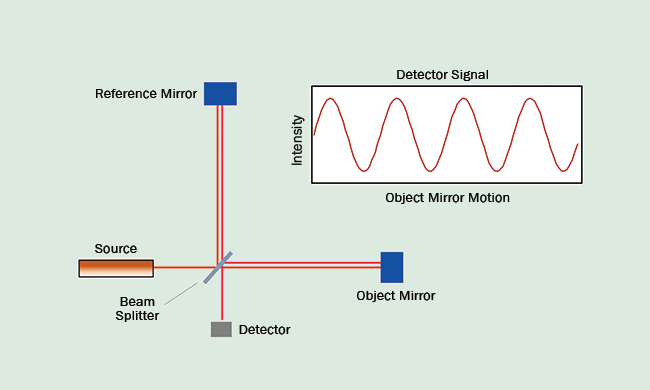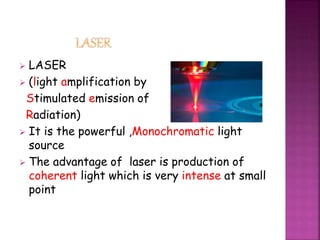The homodyne interferometer using a HeNe laser as its source is a commonly used position sensor in FT spectrometers. There are different interferometer set ups based on Michelsons principle however the linear set up is the simplest type to explain.

Laser Light Properties Laser Technologies 2016 Download Scientific Diagram
1231 Laser holographic interferometry.

. Laser holographic interferometry is a technique combining laser interferometry and holography. With software analysis of the interference pattern a hard. For the majority of our mirrors we use a phase shifting interferometer for quality assurance.
123 Laser interferometry or electronic speckle pattern interferometry. Heliumneon laser interferometers have been used in pulsed plasma applications such as the field-reversed configuration 2 z-pinch 3 spheromak 4 and plasma opening switch 5. The laser beam wavelength is exact and pure for highly accurate measurements.
Interferometer uses ac laser as light source and thus used to measure large distance the laser beam wavelength is exact and pure for highly accurate measurements. Now two rapidly growing fields laser radar lidar and dense wavelength-division multiplexing DWDM are putting new demands on the way we use interferometry to support the special measurement requirements of these applications. There are two types of laser interferometer they are homodyne and heterodyne a homodyne interferometer uses a single frequency laser source whereas a heterodyne interferometer uses a laser source with two close frequencies.
Common Challenges We Solve. Interference is a phenomenon that occurs when two waves of any kind come together at the same time and place. The Laser Interferometer Gravitational-Wave Observatory LIGO uses two 4-km MichelsonFabryPérot interferometers for the detection of gravitational waves.
Laser interferometer uses AC laser as the light source and the measurements to be made over longer distance. L4 Lasers The L4 is a pivotal design for researchers conducting power sensitive research in the midwave and longwave infrared spectral regime. A first series of clinical measurements of patients with angiological problems has shown a clear correlation of the.
Light from a powerful laser is split into 2 long orthogonal paths and reflected against mirrors attached to test weights at the end of the arms. This phenomenon can be used 1 to measure fundus tissue pulsations and 2 to measure the optical length of the eye. Fixed internal cube corners 4.
Since 2019 also the LIGO and the Virgo observatories have been using squeezed light 56. In this application the FabryPérot cavity is used to store photons for almost a millisecond while they bounce up and down between the mirrors. I want to know if it is possible to use laser interferometer on object with rough texture that is not like mirror kind of like matte paint that scatters incoming light and on object whose geometry is such that the surface will be angled and curved at the point where the laser beam will aim it will not be flat directly facing the laserAlso it will move not just perfectly.
External cube corners 5. This paper proposes a method for measuring distance larger than the wavelength of light with an interferometer using a laser diode. Laser Interferometry 2 Articles.
The 2 returning light beams are made interfere with each other creating interference fringes. There are two types of laser interferometers. 11 A Brief Laser Primer First a few words about lasers and how they work.
Laser interferometry or ESPI also known as computer-aided speckle pattern interferometry CASPI television holography and video holography is the electronic processing of speckle patterns produced by a laser interferometer consisting of two laser beams using a beam splitter generated from the. Laser is a monochromatic optical energy which can be collimated into a directional beam AC. The principle of holography is based on the fact that via simultaneously recording a reference light laser beam split by a beam splitter and a returned scattered light beam from the surface of a target on a holographic plate.
The two most common types of interferometers are the Fabry-Perot and Michelson designs. Laser interferometers that are operated with squeezed light reach higher sensitivites with the same light power. The L3 is the worlds smallest CO 2 laser providing a portable light source that can be battery powered for field use.
Since 2010 the gravitational-wave detector GEO600 has been using squeezed light in all its observational runs 4. The word LASER is an acronym for Light Amplification by. The measure is done by looking at the intensity of the light exiting from the interferometer.
In the XL-80 laser system the two mirrors used in the Michelson interferometer are retroreflectors prisms that reflect the incident light back in the direction parallel to the direction from which it came from. Looking at the scheme in figure you can suppose for simplicity that the light source inject a plane electromagnetic wave in the input port. Laser interferometer ACLI has the following advantages.
All Cobolt DPSS lasers are single longitudinal mode with coherence lengths 10m and are thus a very suitable choice of laser for any interferometric application. A homodyne interferometer uses a single-frequency laser source whereas a heterodyne interferometer uses a laser source with two close frequencies. Older laser diodes often used these photodiodes to control the light emitted by the laser junction.
The term interferometry derives from the word interference. If the pupil of the eye is illuminated by a collimated laser beam the light returning from the eye exhibits Newtons interference fringes. Laser interferometer to determine the time-resolved electron number density in a propagating high density current sheet and in its wake.
Laser interferometer uses AC laser as the light source and thus it enables the measurements to be made over longer distance. Detection with interferometers Most promising technique use laser interferometry of the Michelson type. Two frequency zeeman laser 2.
Interferometry uses laser light to generate interference patterns that can be interpreted to measure the flatness radius of curvature or angle of a laser optic as well as other properties. Measure distance using this interferometer and then you will use the interferometer to examine the small motions of a oscillating mechanical system. The light is splitted in two parts by the beam splitter and then recombined.
Laser represents a source of intensively monochromatic optical energy which can be collimated into a directional beam. This method uses the.

Interferometry Measuring With Light Test Measurement Photonics Handbook Photonics Marketplace

0 Comments